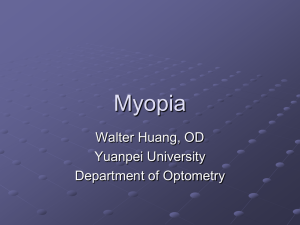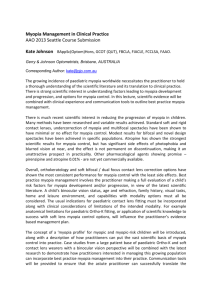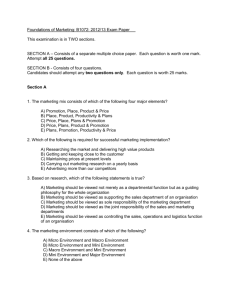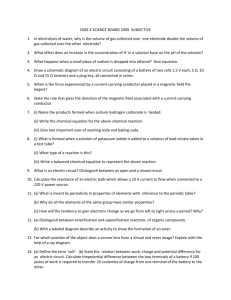20. Cho P, Cheung SW, Mountford J, White P: Good clinical practice
advertisement
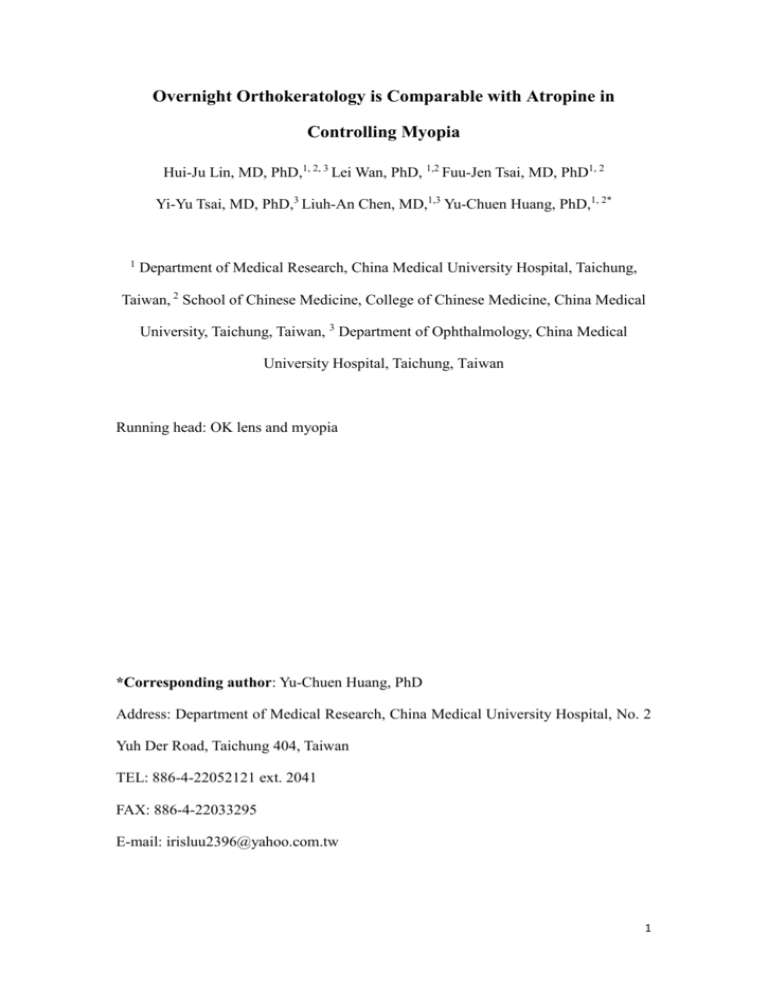
Overnight Orthokeratology is Comparable with Atropine in Controlling Myopia Hui-Ju Lin, MD, PhD,1, 2, 3 Lei Wan, PhD, 1,2 Fuu-Jen Tsai, MD, PhD1, 2 Yi-Yu Tsai, MD, PhD,3 Liuh-An Chen, MD,1,3 Yu-Chuen Huang, PhD,1, 2* 1 Department of Medical Research, China Medical University Hospital, Taichung, Taiwan, 2 School of Chinese Medicine, College of Chinese Medicine, China Medical University, Taichung, Taiwan, 3 Department of Ophthalmology, China Medical University Hospital, Taichung, Taiwan Running head: OK lens and myopia *Corresponding author: Yu-Chuen Huang, PhD Address: Department of Medical Research, China Medical University Hospital, No. 2 Yuh Der Road, Taichung 404, Taiwan TEL: 886-4-22052121 ext. 2041 FAX: 886-4-22033295 E-mail: irisluu2396@yahoo.com.tw 1 Abstract Background: Many efforts have been invested in slowing progression of myopia. Among the methods, atropine administration and orthokeratology (OK) are most widely used. This study analyzed the efficacy of atropine and OK lens in controlling myopia progression and elongation of axial length. Methods: This retrospective study included 105 patients (210 eyes) who wore OK lenses and 105 patients (210 eyes) who applied 0.125% atropine every night. Student t-test, linear regression analysis, repeated measure ANOVA, and Pearson’s correlation coefficient were used for statistical analysis. Results: Linear regression analysis revealed an increase in myopia of 0.28 D and 0.34 D per year, and an increase in axial length of 0.28 mm and 0.37 mm per year in the OK lens and atropine groups, respectively. Repeated measure ANOVA showed significant differences in myopia (p = 0.001) and axial length (p < 0.001) between the atropine and OK lens groups; in astigmatism, there was no significant difference in these parameters (p = 0.320). Comparison of increases in axial length in relation to baseline myopia showed significant correlations both in the OK lens group (Pearson’s correlation coefficient, r = 0.259; p < 0.001) and atropine group (r = 0.169; p = 0.014). High myopia patients benefited more from both OK lenses and atropine than did low myopia patients. The correlation of baseline myopia and myopia progression was stronger in the OK lens group then in the atropine group. Conclusions: OK lens is a useful method for controlling myopia progression even in high myopia patients. Key words: Atropine; axial length; cornea endothelium; myopia; orthokeratology 2 Background Myopia is the most common ocular disorder in the world. The prevalence of myopia is about 20%–30% in North American, Australian, and European populations [1-3], and much higher (40%–70%) in the Asian population [4-6], especially in China [7-9]. Myopia is an important public health problem because it is associated with increased risk for chorioretinal degeneration, retinal detachment, and other vision-threatening abnormalities [10,11]. Several therapeutic methods exist for the correction of myopia, such as corrective spectacles, contact lenses, keratorefractive surgeries, intraocular lenses (IOLs), and clear lens extraction [12-14]. However, possible aftermaths of keratorefractive surgeries of high refractive errors, such as glare, halo, and contrast sensitivity have been reported [15,16]. Therefore, prevention of high myopia is of utmost importance. The nonselective muscarinic acetylcholine receptor (mAChR) antagonist, atropine, slows down myopia progression in a dose-dependent manner as compared with that in a placebo-treated group [17-19]. Atropine has proved useful both in animal studies and human clinical trials and is now widely used to control progression of myopia. However, myopia is never completely resolved. In atropine users, increasing intraocular pressure and photo-stress of the crystalline lens and retina are often concerned; photophobia and poor near vision are often to be confronted with. Orthokeratology (OK) uses specially designed rigid contact lenses to reshape the cornea in order to temporarily reduce or eliminate refractive error [20,21]. Modern OK using sophisticated contact lenses with a reverse-geometry design can provide faster, larger, and more predictable refractive changes than OK lenses used in the original method introduced in the early 1960s [22]. Overnight OK lenses can decrease the patient’s need to wear contact lenses or spectacles in the daytime by providing 3 acceptable vision for normal routine activity. The presumed mechanisms of OK lens-induced myopic reduction include central corneal flattening, thinning of the central corneal epithelium [23,24], thickening of the mid-peripheral cornea, and peripheral vision myopic shift [25]. However, several studies report that OK lenses increase higher-order aberrations of the cornea and decrease contrast sensitivity [26,27]. Despite controversies related to safety issues, OK lens use is becoming increasingly popular [20]. High myopia is one of the major causes of legal blindness, and many efforts have been invested into slowing elongation of axial length and decreasing myopia progression. Myopia is a popular eye disease in Asia and high myopia induces severe retinopathy or other complication is not uncommon. In our country, every student must receive eyes’ examination at the begging of the semesters and schools have the responsibility to send the report to Health Department of Government. The students have myopia all will be referred to hospital for regular examination and treatment. Students visit department of Ophthalmology for controlling myopia is very common in our country and the patients in this study were collected from these outpatient departments. In this study, two of the currently most useful methods in controlling myopia are compared: OK lenses and 0.125% atropine. Refractive errors, axial length, and endothelium cell count were analyzed to determine the effects of the two groups in controlling myopia progression. 4 Patients and Methods This is a retrospective cohort study, the patients using myopia or OK lens were grouped according to the selection of the patients themselves; no special recommendations were done in our department. At the time of treatment, the patients and their families understood the different methods for treating myopia and selected the method themselves. Patients with complete clinical data during the study period (3 years, from March 2009 to March 2012) and who agreed to undergo full and regular examinations were included in this study. We randomly selected a total of 105 patients who used OK lens and 105 patients who used 0.125% atropine (Wu-Fu pharmaceutical Cc., Inc., YiLan, Taiwan) every night before sleep. The study was approved by the ethics committee of China Medical University Hospital (Taichung, Taiwan) and was performed in accordance with the tenets of the Declaration of Helsinki for research involving human subjects. Informed consent was obtained from all participants. According the “Processed Personal Data Protection Law” in our country, informed consult must be given to the persons themselves or their “Legal Representative” when we want to use their data for research. This study had reviewed by the “Institutional review board” following regular program. The informed consults were given to volunteers when we began to collect the data. Comprehensive ophthalmic examinations were performed before treatment and at every visit. None of the participants had ocular insult or disease such as retinopathy, prematurity, neonatal problems, a history of genetic disease, and connective tissue disorders associated with myopia such as Strickler or Marfan syndromes. Clinical examinations included visual acuity, refraction error, slit lamp examination, ocular movements, intraocular pressure, and fundoscopy. Patients with organic eye disease, a history or evidence of intraocular surgery, and history of cataract were excluded from this study (Table 1). 5 Non-cycloplegic subjective vision and cycloplegic objective refraction recorded at the visits before commencement of 0.125% atropine or OK lens treatment (baseline) and 1, 2, and 3 years after were compared. All participants had a visual acuity with distance correction of 0.1 logMAR (20/25) or better. The refractive error (in diopters [D]) of two eyes of each individual was measured after administering one drop of cycloplegic drug (1% mydriacyl; Alcon, Berlin, Germany). Two eyes of each patient were assayed individually. Individuals with myopia from 1.5 to 7.5 D (average, 4.25 ± 1.5 D) and astigmatism from 0 to 2.75 D (average, 0.75 ± 0.75 D) (negative cylinder was used in this study) were included in this study; cases of extreme high myopia (over 9 D) and astigmatism (over 3 D) were excluded. Auto-refraction (Autorefractor/auto-keratometer [ARK 700A; Nikon, Tokyo, Japan]) was conducted for both eyes by experienced optometrists who were trained and certified in the study protocols. Refractive data, sphere (s), negative cylinder (c), and axis measurements were analyzed. Patients who applied atropine ophthalmic eye drops received one drop of 0.125% atropine every night before sleep and wore glasses prescribed by a certified ophthalmologist and modified according to any refractive changes during the follow-up period. The OK lenses used in this study were 4-zone, reverse-geometry lenses (Emerald Lenses; Euclid Systems Corp., Herndon, VA, manufactured from Boston XO material; Polymer Technology Corp., Wilmington, MA) with a nominal Dk of 100 × 10-11 cm2/s)(mL O2/mL·mmHg). The nominal central thickness of the lenses was 0.22 mm, and the diameter was 10.4–11.0 mm. The parameters of the lenses were varied to achieve good centration and good fluorescein pattern. After the lenses were dispensed, the patients were advised to wear them every night for at least 6–8 consecutive hours. The patients of the 2 groups returned for examination every 3 months and underwent slit lamp examinations for any adverse events. The OK lens fit 6 was evaluated at these visits. OK lenses and spectacles were replaced if visual acuity was worse than 0.30 logMAR during the follow-up. Refraction, visual acuity, axial length, and corneal endothelium cell count obtained before initiation of the treatments were used as the baseline values; measurements were obtained every 3 months thereafter. The axial length was evaluated using a noncontact optic biometric device (IOL Master; Carl Zeiss Meditec AG, Jena, Germany) between 2 and 4 pm. On each occasion, 5 successive measurements were obtained, and their mean was used as a representative value. The measurements were obtained by a single examiner. Changes in axial length were evaluated prospectively and compared. Noncontact specular microscopy of the central corneal endothelium was performed with an SP-2000 specular microscope (Topcon Co, Tokyo, Japan), and endothelial photographs were taken. Subsequently, the Topcon IMAGEnet processing system (Topcon) was used to analyze these images. The boundaries of at least 100 cells per image were digitized, and the mean endothelial cell density, coefficient of variation of cell area, and percentage of hexagonal cells were calculated. Data are presented as ranges or means ± standard deviation. A student t-test was used to compare the baseline conditions of the two groups. Linear regression, repeated measure ANOVA and Pearson’s correlation coefficient analyses were performed to compare the results. A p value <0.05 represented significant in this study. 7 Results In the OK lens group, 105 patients (53 males and 52 females) who successfully completed the 3-year follow-up examinations were enrolled. Their ages ranged from 7 to 17 years (average, 11.82 ± 1.25 years). Sixteen (15.24%) patients were aged 7–9 years, 70 (66.67%) were aged 10–13 years, and 19 (18.83%) were aged 14–17 years (Table 2). At baseline, their myopia ranged from 1.5 to 7.5 D (average, 4.25 ± 1.5 D), and astigmatism ranged from 0 to 2.75 D (average, 0.75 ± 0.75 D); logMAR uncorrected visual acuity (UCVA) was between 0.20 and 1.40 logMAR (mean, 0.80 ± 0.45), and axial length ranged from 22.05 to 27.05 mm (mean, 24.12 ± 1.25 mm; Table 2). In the atropine group, 105 patients (53 males and 52 females) used 0.125% atropine every night throughout the 3-year follow-up (Table 2). Their ages ranged from 7 to 17 years (average, 10.2 ± 1.98 years). Twenty-three (21.91%) patients were aged 7–9 years, 70 (66.67%) were aged 10–13 years, and 12 (11.41%) were aged 14–17 years. Among the 105 subjects, 90 (90.5%) patients required spectacles to perform daily activities. At baseline, their myopia ranged from 1.5 to 7.5 D (average, 4.0 ± 1.75 D; Table 2) and astigmatism was between 0 and 2.75 D (average, 0.5 ± 0.75 D; Table 2); UCVA ranged from 0.10 to 1.40 logMAR (mean, 0.81 ± 0.28; Table 2), and axial length ranged from 21.12 to 27.23 mm (mean, 24.23 ± 1.35 mm; Table 2). At baseline, the 2 groups were comparable in terms of myopia (p = 0.975), astigmatism (p = 0.897), and axial length (p = 0.985) (Table 2). All demographic data on UCVA, axial length, age, and gender are listed in Table 2; there were no significant differences in all the baseline conditions between the groups. Using linear regression analysis, we found that myopia increased by 0.28 D ± 0.18 D and 0.34 D ± 0.21 D per year in the OK lens group and the atropine group, respectively (Table 3). The change in myopia diopters per year was 0.29 ± 0.31 D, 8 0.27 ± 0.24 D, and 0.28 ± 0.31 D in the OK lenses group, and 0.31 ± 0.19 D, 0.35 ± 0.85 D, and 0.32 ± 0.53 D in the atropine group for years 1, 2, and 3, respectively (Table 4). The change in axial length per year was 0.28 ± 0.08 mm and 0.37 ± 0.09 mm in the OK lens group and the atropine group, respectively (Table 3). The change in axial length per year was 0.28 ± 0.08 mm, 0.30 ± 0.09 mm, and 0.27 ± 0.10 mm in the OK lens group, and 0.38 ± 0.09 mm, 0.37 ± 0.12 mm, and 0.36 ± 0.08 mm in the atropine group for years 1, 2, and 3, respectively (Table 4). Astigmatism (analyzed using a negative cylinder) changed by ±0.02 D and ±0.01 D per year in the OK lens group and the atropine group, respectively (Table 3); the axis of astigmatism did not show significant changes during the study period in the 2 groups. The change in mean cornea endothelium cell count was not significantly different between the OK lens and atropine group (change per year, ±38 cell/mm2 and ±30 cell/mm2; p = 0.785). The UCVA of the OK lens group was 0.2 logMAR (20/30) to -0.1 logMAR (20/16), and BCVA of the atropine group was 0.1 logMAR (20/25) to -0.1 logMAR (20/16) at 2 and 4 pm, respectively. To understand the relationship between the refractive error at baseline and increased axial length, Pearson’s correlation coefficient was employed. Significant correlation was found between these parameters in the OK lens group (Pearson’s correlation coefficient; r = 0.259, p < 0.001) as well as in the atropine group (r = 0.169, p = 0.014; Figs. 1, 2). The effect of decreasing the progression of axial length was more pronounced in high myopia patients than in low myopia patients for both groups. The regression coefficient () was higher in the OK lens group than in the atropine group ( = 0.060 [OK lens group] and 0.029 [atropine group], respectively). In the OK lens group, the most common complication was allergic conjunctivitis; in 37 eyes (17.6%), there was an uncomfortable feeling such as itching 9 during daytime, watery discharge on awaking, and requirement of drugs for relieving the symptoms. Fifteen eyes (7.14%) showed superficial keratitis, which improved 3–7 days after terminating the use of OK lenses, without the need for drug administration. No other complications, including corneal ulcers, were noted. In the atropine group, 2 eyes (1 patient [0.095%]) showed mild allergic blepharitis, which improved after topical application of anti-allergy medication. The major complaints of atropine application were photophobia during the day (35%), which could be resolved by photochromic lenses or sunglasses (72%), and poor near visual acuity (12%), which could be improved by multifocal lenses in most patients (96%). No other evident abnormality was noted during the treatment period. 10 Discussion Atropine is a well-known drug for treating myopia. In this study, OK lens is effective in slowing progression of myopia and increasing of axial length over a period of 3 years and is compatible with the effect of atropine. The data presented in this study, the increase in axial length was 0.28 ± 0.08 mm per year in the OK lens group versus 0.37 ± 0.11 mm per year in the atropine group. In 2005, Cho et al. reported that axial length increased by 0.29 ± 0.27 mm in the OK lens group and 0.54 ± 0.27 mm in a control group treated with spectacles during a 2-year follow-up [28]. In 2009, Walline et al. reported similar findings; the mean increase in axial length after 2 years was 0.25 mm in the OK group and 0.57 mm in the control group [29]. In 2011, Kakita et al. obtained similar changes of 0.39 ± 0.27 mm in the OK lens group versus 0.61 ± 0.24 mm in the control spectacles group over 2 years [30]. The study of Walline et al. was performed with American patients, in whom the progression of myopia is reportedly slower than in the Asian population; this may explain the lesser increase in axial length in their study [29]. The results of Kakita et al. were obtained in Japan with an ethnic group similar to ours, and their results are similar to those of our study [30]. The increase in axial length in our OK lens group (0.28 ± 0.08 mm per year) was less than that reported by Cho et al. (0.54 ± 0.27 mm in 2 years). The study of Cho et al. was performed in Hong Kong, in an area with high prevalence of myopia. Differences in the results may be because they used an ultrasonic A-mode device to measure axial length. In the present study, laser interferometry (IOLMaster; Carl Zeiss Meditec) was used to obtain noncontact measurements of axial length. This method has high reproducibility, and the non-contact procedure decreases the influences induced by compression of the cornea [31]. The increase in axial length in our control group was the smallest among all the studies mentioned above. This may 11 be because our control group used 0.125% atropine, and atropine is effective in decreasing myopia progression and axial length increase. Nevertheless, there were significant difference between the OK lens group and the 0.125% atropine group in quantity of axial length and myopic diopters. The major limitation of our study is that the myopic diopter and axial length were checked every year after discontinuing use of OK lenses for 3 weeks; 3 weeks may not enough for the refractive error to completely recover to the baseline condition. However, patients in the OK lens group often relied on the OK lenses for their daily vision and could not discontinue use of the OK lens for 4–6 weeks, and 4–6 weeks has been proved to be sufficient for restoration of corneal curvature to the baseline condition so that the exact myopia diopter can be determined. This limitation is offset by the fact that the axial length, which is not influenced to a great extent by use of the OK lens, was also measured in this study, and a significant difference in axial length was found. Another limitation of our study is that age may influence the progression of myopia. A previous study demonstrated that myopia increased most remarkably at the age of 10–13 years; therefore, if we assessed only 10- to 13-year-old patients, the differences in myopic degree and axial length between the 2 groups were still observed, but to a lesser extent (p = 0.003 and p = 0.0035, respectively). However, the sample number was decreased after age stratification. Therefore, a larger study sample is required for future studies based on age stratification. Some of OK lens users exhibited UCVA greater than 0.2 logMAR (20/30) or had obvious fluctuations in diurnal UCVA. These patients often had a flatter cornea curvature, irregular cornea surface, or tight eyelids. The limitations of OK lenses are obvious, and the tight eyelids of Asian subjects are a substantial concern. Although the new multiple-zone, reverse-geometry lenses have a better outcome, not all patients 12 are satisfied with the OK lens. No severe corneal infection occurred in this study group; it is important to educate the patients and their families about maintenance of healthy habits and appropriate handling of OK lenses. Patients with high myopia at baseline showed less severe increase in axial length than those with low myopia in both the OK lens and atropine groups. The linear correlation was more significant in the OK lens group then in the atropine group (r = 0.259 versus r = 0.169). This phenomenon may occur because peripheral refraction changes are more evident in high myopia patients with OK lenses. Myopic eyes usually have relative hyperopic defocus in the periphery, because the eye is elongated along the optic axis. Recent studies suggest that peripheral vision can influence axial length in human eyes, potentially altering the central refractive error and its development because of the emmetropization effect of eye growth. Conversion of relative peripheral hyperopia to relative peripheral myopia is a good method to limit the axial elongation that leads to myopia [25,32] and OK lenses appear to be an excellent option for achieving this objective. OK lenses appear to be a good tool to control high myopia. OK lenses create a small central zone and a smaller central visual field, with a greater area of the peripheral field remaining myopic; this would be expected to decrease axial length elongation [33]. More human and animal studies are required to clearly test this hypothesis. However, clear central vision is essential for preventing defocus-inducing myopia. The efficacy and safety of atropine is undoubted. Nevertheless, increasing intraocular pressure and photo-stress of the crystalline lens, retina, photophobia and poor near vision are often to be concerned in the patients using atropine. OK lens with well care and hygiene may be one of the good policies to prevent progression of myopia and it does not just bring convenience for myopic patient to remove glasses in daytime. The combined use of OK lenses and atropine is a potential treatment for 13 myopia progression and is being tested at our department. Hope this can resolve myopic problems further. Abbreviations: IOL: intraocular lenses; mAChR: muscarinic acetylcholine receptor; OK: Orthokeratology; D: diopters; logMAR: logarithm of the minimum angle of resolution. UCVA: un-corrected visual acuity; BCVA Best corrected visual acuity Competing interests All authors declare that they have no competing interests. Authors’ contributions HJL has collected the data of the trial, designed the study and drafted the manuscript. LW participated in the design of the study and critically revised the manuscript. FJT collected the data and participated in the design of the study. YYT participated in its design and coordination. LAC has collected the data of the trial and participated in its design and coordination. YCH performed the statistical analysis has given final approval of the version to be published. 14 Acknowledgments: This study was supported by National Science Council Taiwan (NSC 99-2314-B-039-011-MY3). Moreover, we also thank the grants from China Medical University Hospital (DMR-100-097 and DMR-101-074, Taichung, Taiwan). We gratefully acknowledge Emily Hsieh and Chia Ming Wu from Department of Medical Genetics, China Medical University Hospital, Taichung, Taiwan for helping dealing experiment. 15 References 1. Midelfart A, Midelfart S: Prevalence of refractive errors among adults in Europe. Arch Ophthalmol 2005, 123:580. 2. Kempen JH, Mitchell P, Lee KE, Tielsch JM, Broman AT, Taylor HR Ikram MK, Congdon NG, O'Colmain BJ; Eye Diseases Prevalence Research Group: The prevalence of refractive errors among adults in the United States, Western Europe, and Australia. Arch Ophthalmo 2004, 122:495-505. 3. Rose K, Smith W, Morgan I, Mitchell P: The increasing prevalence of myopia: implications for Australia. Clin Experiment Ophthalmol 2001, 29:116-120. 4. Sawada A, Tomidokoro A, Araie M, Iwase A, Yamamoto T: Refractive errors in an elderly Japanese population: the Tajimi study. Ophthalmology 2008, 115:363-370. 5. Wong TY, Foster PJ, Hee J, Ng TP, Tielsch JM, Chew SJ, Johnson GJ, Seah SK: Prevalence and risk factors for refractive errors in adult Chinese in Singapore. Invest Ophthalmol Vis Sci 2000, 41:2486-2494. 6. Pan CW, Wong TY, Lavanya R, Wu RY, Zheng YF, Lin XY, Mitchell P, Aung T, Saw SM: Prevalence and risk factors for refractive errors in Indians: the Singapore Indian Eye Study (SINDI). Invest Ophthalmol Vis Sci 2011, 52:3166-3173. 7. Liu HH, Xu L, Wang YX, Wang S, You QS, Jonas JB: Prevalence and progression of myopic retinopathy in Chinese adults: the Beijing Eye Study. Ophthalmology 2010, 117:1763-1768. 16 8. He M, Zheng Y, Xiang F: Prevalence of myopia in urban and rural children in mainland China. Optom Vis Sci 2009, 86:40-44. 9. Zhang M, Li L, Chen L, Lee J, Wu J, Yang A Chen C, Xu D, Lam DS, Sharma A, Griffiths S, Gao Y, Congdon N: Population density and refractive error among Chinese children. Invest Ophthalmol Vis Sci 2010, 51:4969-4976. 10. Moriyama M, Ohno-Matsui K, Shimada N, Hayashi K, Kojima A, Yoshida T Tokoro T, Mochizuki M: Correlation between visual prognosis and fundus autofluorescence and optical coherence tomographic findings in highly myopic eyes with submacular hemorrhage and without choroidal neovascularization. Retina 2011; 31:74-80. 11. Ikuno Y, Jo Y, Hamasaki T, Tano Y: Ocular risk factors for choroidal neovascularization in pathologic myopia. Invest Ophthalmol Vis Sci 2010; 51:3721-3725. 12. Kawesh GM, Kezerian GM: Laser in situ keratomileusis for high myopia with the VISX star laser. Ophthalmology 2000; 107:653–661. 13. Huang D, Schallhorn SC, Sugar A, Farjo AA, Majmudar PA, Trattler WB, Tanzer DJ: Phakic intraocular lens implantation for correetion of myopia: A report by the American academy of ophthalmology. Ophthalmology 2009; 116:2244–2258. 14. Pesando PM, Ghiringhello MP, Di Megilo G, Fanton G: Posterior chamber phakic intraocular lens for hyperopia: Ten-year follow-up. J Cataract Refract Surg 2007, 33:1579–1584. 15. Tuan KM, Liang J: Improved contrast sensitivity and visual acuity after wavefront-guided laser in situ keratomileusis: in-depth statistical analysis. 17 J Cataract Refract Surg 2006, 32:215-220. 16. Oshika T, Okamoto C, Samejima T, Tokunaga T, Miyata K: Contrast sensitivity function and ocular higher-order wavefront aberrations in normal human eyes. Ophthalmology 2006, 113:1807-1812. 17. Shih YF, Hsiao CK, Chen CJ, Chang CW, Hung PT, Lin LL: An intervention trial on efficacy of atropine and multi-focal glasses in controlling myopic progression. Acta Ophthalmol Scand 2001; 79:233-236. 18. Cottriall CL, Truong HT, McBrien NA: Inhibition of myopia development in chicks using himbacine: a role for M(4) receptors? Neuroreport 2001; 12:2453-2456. 19. Siatkowski RM, Cotter S, Miller JM, Scher CA, Crockett RS, Novack GD, US Pirenzepine Study Group: Safety and efficacy of 2% pirenzepine ophthalmic gel in children with myopia: a 1-year, multicenter, double-masked, placebo-controlled parallel study. Arch Ophthalmol 2004; 122:1667-1674. 20. Cho P, Cheung SW, Mountford J, White P: Good clinical practice in orthokeratology. Cont Lens Anterior Eye 2008; 31:17-28. 21. Swarbrick HA: Orthokeratology review and update. Clin Exp Optom 2006; 89:124-143. 22. Tahhan N, Du Toit R, Papas E, Chung H, La Hood D, Holden AB: Comparison of reverse-geometry lens designs for overnight orthokeratology. Optom Vis Sci 2003; 80:796-804. 23. Reinstein DZ, Gobbe M, Archer TJ, Couch D, Bloom B: Epithelial, stromal, and corneal pachymetry changes during orthokeratology. Optom Vis Sci 2009; 86: E1006-1014. 18 24. Zhong X, Chen X, Xie RZ, Yang J, Li S, Yang X, Gong X: Differences between overnight and long-term wear of orthokeratology contact lenses in corneal contour, thickness, and cell density. Cornea 2009; 28:271-279. 25. Kang P, Swarbrick H: Peripheral refraction in myopic children wearing orthokeratology and gas-permeable lenses. Optom Vis Sci 2011; 88:476-482. 26. Stillitano I, Schor P, Lipener C, Hofling-Lima AL: Long-term follow-up of orthokeratology corneal reshaping using wavefront aberrometry and contrast sensitivity. Eye Contact Lens 2008; 34:140-145. 27. Hiraoka T, Okamoto C, Ishii Y, Okamoto F, Oshika T: Recovery of corneal irregular astigmatism, ocular higher-order aberrations, and contrast sensitivity after discontinuation of overnight orthokeratology. Br J Ophthalmol 2009; 93:203-208. 28. Cho P, Cheung SW, Edwards M: The longitudinal orthokeratology research in children (LORIC) in Hong Kong: a pilot study on refractive changes and myopic control. Curr Eye Res 2005; 30:71-80. 29. Walline JJ, Jones LA, Sinnott LT: Corneal reshaping and myopia progression. Br J Ophthalmol 2009; 93:1181-1185. 30. Kakita T, Hiraoka T, Oshika T: Influence of overnight orthokeratology on axial elongation in childhood myopia. Invest Ophthalmol Vis Sci 2011; 52:2170-2174. 31. Olsen T, Thorwest M: Calibration of axial length measurements with the Zeiss IOLMaster. J Cataract Refract Surg 2005; 31:1345-1350. 19 32. Queirós A, González-Méijome JM, Jorge J, Villa-Collar C, Gutiérrez AR: Peripheral refraction in myopic patients after orthokeratology. Optom Vis Sci 2010; 87:323-329. 33. Charman WN, Mountford J, Atchison DA, Markwell EL: Peripheral refraction in orthokeratology patients. Optom Vis Sci 2006; 83: 641-648. Figure Legends Fig 1. Increases in axial length (mm) and refractive errors (myopia [D]) at baseline in the OK group. A significant correlation was found between the increases in axial length and spherical equivalent refractive errors (myopia [D]) at the baseline. Pearson’s correlation coefficient: r = 0.259, p < 0.001 Fig 2. Increases in axial length (mm) and refractive errors (myopia [D]) at baseline in the atropine used group. A significant correlation was found between the increases in axial length and spherical equivalent refractive errors (myopia [D]) at the baseline. Pearson’s correlation coefficient: r = 0.169, p = 0.014 20 Tables Table 1 Inclusion and exclusion criteria Exclusion criteria Retinopathy Prematurity Neonatal problems History of genetic disease Connective tissue (eg. Strickler or Marfan syndromes) Organic eye disease Intraocular surgery (eg. history of cataract) Inclusion criteria Aged: 7-17 year-old (average 10±2.3 year-old) Myopia: 1.5D to 7.5D (average 4.25D ± 1.5D) Astigmatism: 0 D to 2.75D (average 0.75D ± - 0.75) Follow up: 6-40 months (24 ± 1.8 months) Distance correction: 0.1 log MAR (20/25) or better 21 Table 2 Baseline data of patients in the OK lens and atropine group OK# (mean±SD) Atropine$ (mean±SD) Age, y/o 11.82 ± 1.25 11.12 ± 1.68 Sex, M/F 1: 0.99 1:098 0.987 Myopia (Dd) 1.5 to 7.5 1.5 to 7.5 0.975 (4.25 ± 1.5) (4.0 ± 1.75) 0 to 2.75 0 to 2.75 (0.75 ± 0.75) (0.5D ± 0.75) UCVA* (log MARb) 0.8 ± 0.45 0.81 ± 0.28 0.982 BCVAa (log MAR) 0.1± 0.015 0.12 ± 0.05 0.876 Axial length (mm) 24.12 ± 1.25 24.23 ± 1.35 Astigmatism (D) # p value 0.745 0.897 0.985 OK: Orthokeratology $ 0.125% atropine * UCVA: Uncorrected visual acuity a BCVA: Best corrected visual acuity b log MAR: logarithm of the Minimum Angle of Resolution d D: diopter 22 Table 3 Predictors of myopia and astigmatism between atropine and OK lens groups by linear regression analysis Dependent variable Regression coefficient Repeated measure (95% confidence interval) ANOVA (between the two groups) Myopia Astigmatism Axial Length # $ OK lens# -0.28 (-0.40 ~ -0.16) atropine$ -0.34 (-0.46 ~ -0.21) OK lens# ± 0.02 (0.05 ~ 0.03) atropine$ ± 0.01 (0.05 ~ 0.02) Ok lens# 0.28 (0.20 ~0.36) atropine$ 0.37 (0.29 ~0.44) p = 0.001 p < 0.001 OK: Orthokeratology 0.125% atropine 23 Table 4 Increase of myopia, stigmatism and axial length in each year Year/myopia (D) OK lens# Atropine$ 1 0.29±0.31 0.31±0.19 2 0.27±0.24 0.35±0.25 3 0.28±0.31 0.32±0.23 Year/astigmatism (D) OK# atropine$ 1 ±0.08±0.11 ±0.03±0.02 2 ±0.08±0.42 ±0.09±0.12 3 ±0.12±0.35 ±0.11±0.16 Year/axial length (mm) OK lens# atropine$ 1 0.28±0.08 0.38±0.09 2 0.30±0.09 0.37±0.12 3 0.27±0.10 0.36±0.08 *Student’s t-test # $ OK: Orthokeratology 0.125% atropine 24




